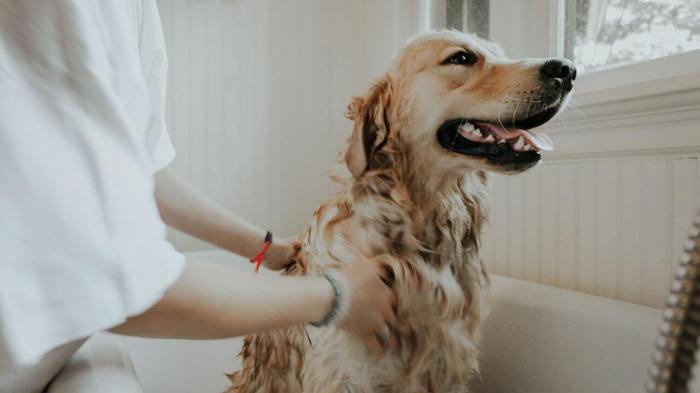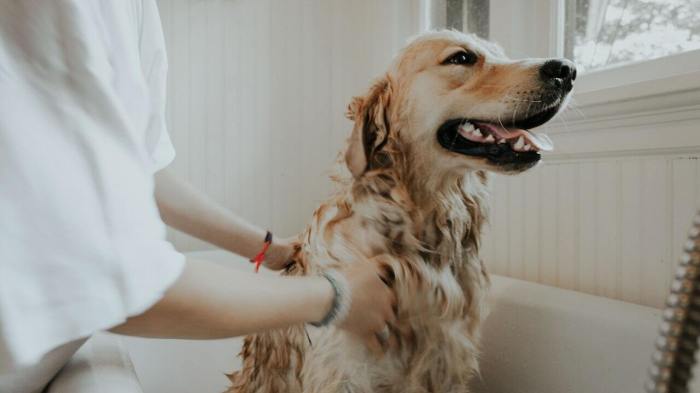Dog shampoo DIY is a fantastic way to give your furry friend a luxurious bath without breaking the bank. You can control the ingredients, ensuring they’re gentle on your dog’s skin and free from harsh chemicals found in many commercial shampoos. Imagine a shampoo tailored specifically to your dog’s needs, whether it’s for sensitive skin, a shiny coat, or even repelling pesky fleas and ticks. This guide will walk you through creating your own dog shampoo, with recipes for various needs and tips for a safe and effective experience.
Commercial dog shampoos can contain fragrances, dyes, and other additives that might irritate your dog’s skin. Making your own shampoo allows you to use natural ingredients like oatmeal, coconut oil, and aloe vera, known for their soothing and moisturizing properties. Not only will your dog appreciate the gentle care, but you’ll also be saving money and reducing waste.
DIY Dog Shampoo for Odor Control

Dealing with unpleasant odors coming from your furry friend can be a challenge. Fortunately, you can create your own dog shampoo that effectively eliminates odors using natural ingredients. This DIY recipe is not only cost-effective but also gentle on your dog’s skin.
Essential Oils for Odor Control
Essential oils are naturally fragrant and can effectively mask unpleasant odors. Some essential oils also have antibacterial and antifungal properties, which can help to prevent odor-causing bacteria from growing on your dog’s skin.
Here are some essential oils that are safe for dogs and can be used to control odor:
- Lavender: Known for its calming and relaxing properties, lavender oil can also help to neutralize unpleasant odors.
- Tea Tree: Tea tree oil has natural antibacterial and antifungal properties, making it effective against odor-causing bacteria.
- Rosemary: Rosemary oil has a refreshing scent and can also help to control odor.
- Lemon: Lemon oil has a citrusy scent that can help to mask unpleasant odors. However, use lemon oil in moderation, as it can be irritating to some dogs’ skin.
Important Note: Always dilute essential oils in a carrier oil, such as coconut oil or almond oil, before applying them to your dog’s skin. Never apply essential oils directly to your dog’s skin.
Choosing Essential Oils for Dogs
When choosing essential oils for your dog, it is important to select oils that are safe and appropriate for their age, breed, and health condition.
- Consult with your veterinarian: It is always best to consult with your veterinarian before using essential oils on your dog, especially if they have any pre-existing health conditions.
- Choose high-quality oils: Look for essential oils that are 100% pure and therapeutic grade. Avoid using essential oils that are diluted or mixed with other ingredients.
- Start with a small amount: Begin by adding a few drops of essential oil to your shampoo. If your dog shows any signs of irritation, discontinue use.
DIY Dog Shampoo for Conditioning: Dog Shampoo Diy
Giving your furry friend a good conditioning treatment can do wonders for their coat, leaving it soft, shiny, and manageable. Homemade dog shampoos offer a natural and cost-effective way to pamper your pup. Let’s explore a simple recipe and understand the importance of conditioning.
Benefits of Conditioning Dog Fur
Conditioning is essential for maintaining the health and appearance of your dog’s fur. It helps to:
- Hydrate and moisturize: Conditioners replenish the natural oils that are stripped away by shampooing, leaving the fur soft and supple.
- Detangle and prevent mats: Conditioners smooth out the hair cuticles, making it easier to brush and preventing tangles and mats.
- Add shine and luster: Conditioners can enhance the natural shine of your dog’s coat, making it look healthier and more vibrant.
- Protect against damage: Conditioners create a protective barrier on the hair shafts, reducing the risk of breakage and damage from brushing, environmental factors, or excessive shedding.
DIY Dog Shampoo for Deep Conditioning
This recipe provides a deep conditioning treatment for your dog’s fur, leaving it soft, manageable, and shiny.
Ingredients:
- 1 cup (240 ml) warm water
- 1/4 cup (60 ml) organic apple cider vinegar
- 2 tablespoons (30 ml) coconut oil
- 1 tablespoon (15 ml) honey
- 1 teaspoon (5 ml) vitamin E oil (optional)
Instructions:
- In a clean bottle, combine all the ingredients.
- Shake well to mix thoroughly.
- Apply the conditioner to your dog’s wet fur, focusing on the ends and any areas that tend to be dry or matted.
- Massage gently into the fur.
- Leave the conditioner on for 5-10 minutes, then rinse thoroughly with warm water.
Tips for Applying and Rinsing Conditioner
- Avoid getting the conditioner in your dog’s eyes or mouth.
- Work the conditioner into the fur gently, avoiding excessive rubbing.
- Rinse thoroughly to remove any residue. Leftover conditioner can leave the fur greasy and attract dirt.
- Use a conditioner specifically formulated for dogs. Human conditioners can contain ingredients that are harmful to dogs.
- Apply conditioner regularly, depending on your dog’s fur type and needs. Dogs with dry or coarse fur may benefit from conditioning more frequently.
Storing and Using DIY Dog Shampoos

You’ve crafted your own dog shampoo, and now it’s time to make sure it stays effective and safe for your furry friend. Proper storage and application are key to maximizing the benefits of your DIY creation.
Storing DIY Dog Shampoos
Storing your DIY dog shampoo properly is essential for extending its shelf life and preventing spoilage.
- Choose the Right Container: Opt for airtight containers made of glass or food-grade plastic to prevent contamination and moisture absorption. Avoid using metal containers as they can react with some ingredients.
- Label and Date: Label your container clearly with the contents, date of creation, and any specific instructions. This will help you keep track of the shampoo’s age and ensure it’s safe to use.
- Store in a Cool, Dry Place: Keep your DIY dog shampoo in a cool, dry location, away from direct sunlight and heat sources. Excessive heat or moisture can degrade the ingredients and shorten the shelf life.
- Avoid Freezing: Freezing DIY shampoos can cause separation and damage the ingredients. Store them at room temperature for optimal results.
Shelf Life of DIY Dog Shampoos, Dog shampoo diy
The shelf life of DIY dog shampoos varies depending on the ingredients used.
- Short Shelf Life: Shampoos containing perishable ingredients like fresh herbs or fruits typically have a shorter shelf life, usually around 2-4 weeks.
- Longer Shelf Life: Shampoos made with more stable ingredients like essential oils and carrier oils can last for several months, sometimes up to 6 months, if stored properly.
Applying and Rinsing DIY Dog Shampoos
Applying and rinsing your DIY dog shampoo effectively ensures a thorough clean and a pleasant experience for your furry friend.
- Wet Your Dog’s Fur: Thoroughly wet your dog’s fur with warm water before applying the shampoo. This helps to loosen dirt and prepare the coat for cleaning.
- Apply Shampoo: Dispense a small amount of shampoo into your hand and work it into a lather. Massage the shampoo into your dog’s fur, avoiding the eyes and ears.
- Rinse Thoroughly: Rinse your dog’s fur thoroughly with clean, warm water until all traces of shampoo are removed. Leftover shampoo can irritate your dog’s skin and leave a residue in their coat.
- Towel Dry: Gently towel dry your dog’s fur after rinsing. Avoid using a hairdryer on high heat, as it can damage their coat.
Creating your own dog shampoo is a rewarding experience, allowing you to customize it to your dog’s specific needs and preferences. With the right ingredients and a little bit of effort, you can give your furry friend a healthy, happy, and beautifully groomed coat. Remember to always patch test any new shampoo on a small area of your dog’s skin before applying it to their entire body. Enjoy the bonding experience and the satisfaction of knowing you’ve created a safe and effective shampoo for your beloved pet.
Making your own dog shampoo can be a fun and rewarding project, especially if you want to use all-natural ingredients. Once you’ve finished whipping up your homemade shampoo, why not create a relaxing outdoor space for your furry friend to enjoy? A DIY outdoor patio is a great way to add a touch of luxury to your pet’s life, and it can be a fun project for the whole family to work on.
After a refreshing bath and a relaxing time on the patio, your dog will be ready for a nap in the sun!

